Meeting No. 5
Solid-ISR
Here are the results of my simulation with the lupolen. In teh simulation I considered
the most simple FF model and radiative losses in terms of peaking approximation. The
elastic kinematics is chosen such, that we sit near the minimum for the 12C FF, which gives
us a useful ratio between H and C.
However, when moving the into the tail region, the tail of the Lupolen spectrum starts to
increase very rapidly. This is due to the fact, that for the ISR diagram FF starts to
increase very fast, when moving away from the minimum. Hence, This rise kills us in the
tail region, where in-spite of good elastic kinematics we end up only with 12C spectrum.
Hydrogen spectrum is suppressed.
The yellow line shows the rescaled pure Hydrogen simulation. Green-line shows the Hydrogen
spectrum extracted from the Lupolen data. The two tails do not match because different
radiative corrections are used. For lupolen they are embedded into the generator, while
for the Hydrogen, we use the standard Simul++ approach.
What shell we do? The Water target is not a good alternative, because we do not
have the pure O2 material for the subtraction.
01.)
Optics:
The determination of the optics matrices is not progressing as fast as I was hoping for. I
continuously find some handicaps that need to be corrected and the whole procedure needs to
be redone, ie: Not all points are included in the analysis, the cuts on y0 are too narrow
causing unwanted offsets, DB entries are wrong, runlist is not ok etc.
I now have matrices for spectrometer A for all three beam energies (195, 360, 495MeV). For B
I have matrix for 195MeV, the 495MeV is being made while the 360MeV still needs to come.
The matrices seem to work reasonably well, only y0 reconstruction for the Spectrometer A
is not working as well as I was hoping for.
Here are results of my analysis and first checks of the matrices. Once all the matrices are
determined I will select a set of runs from all beam energies and make final tests and
(using simulation determine the final resolutions.
Spectrometer A @ 195MeV
Intrinsic resolution:
02.) 03.)
03.)
04.) 05.)
05.)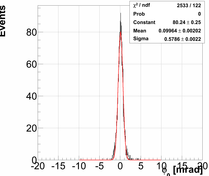
06.) 07.)
07.)
08.)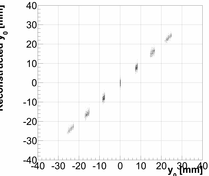 09.)
09.)
10.) 11.)
11.) 12.)
12.)
Vertex resolution:
13.) 14.)
14.) 15.)
15.)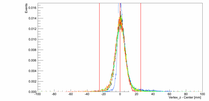 16.)
16.)
Momentum resolution:
17.)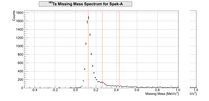 18.)
18.)
Angular resolution:
19.) 20.)
20.) 21.)
21.)
Spectrometer A @ 360MeV
Intrinsic resolution:
22.)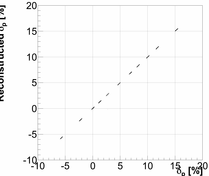 23.)
23.)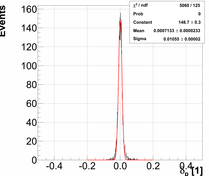
24.) 25.)
25.)
26.) 27.)
27.)
28.) 29.)
29.)
30.)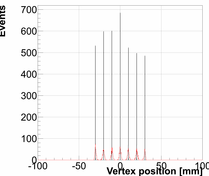 31.)
31.)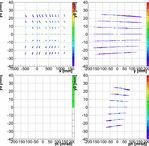 32.)
32.)
Vertex resolution:
33.) 34.)
34.) 35.)
35.)
Momentum resolution:
36.) 37.)
37.) 38.)
38.)
Angular resolution:
39.) 40.)
40.) 41.)
41.)
Spectrometer A @ 495MeV
Intrinsic resolution:
42.) 43.)
43.)
44.) 45.)
45.)
46.) 47.)
47.)
48.) 49.)
49.)
50.) 51.)
51.) 52.)
52.)
Vertex resolution:
53.) 54.)
54.) 55.)
55.) 56.)
56.)
Momentum resolution:
57.) 58.)
58.)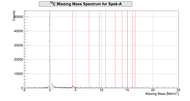 59.)
59.)
Angular resolution:
60.) 61.)
61.) 62.)
62.)
Spectrometer B @ 195MeV
Intrinsic resolution:
63.) 64.)
64.)
65.) 66.)
66.)
67.) 68.)
68.)
69.) 70.)
70.)
71.) 72.)
72.) 73.)
73.)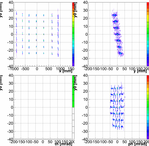
Vertex resolution:
74.)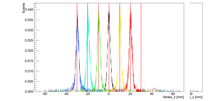 75.)
75.) 76.)
76.)
Momentum resolution:
77.) 78.)
78.)
Angular resolution:
79.) 80.)
80.) 81.)
81.)
Spectrometer B @ 495MeV (work in progress)
Offsets:
82.) 83.)
83.) 84.)
84.) 85.)
85.)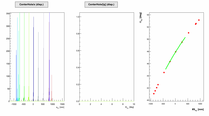
Intrinsic resolution:
86.) 87.)
87.)
88.) 89.)
89.)
90.)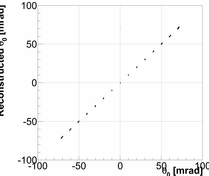 91.)
91.)
92.) 93.)
93.)
94.) 95.)
95.) 96.)
96.)
Last modified: 19/02/2016

 03.)
03.)
 05.)
05.)
 07.)
07.)
 09.)
09.)
 11.)
11.) 12.)
12.)
 14.)
14.) 15.)
15.) 16.)
16.)
 18.)
18.)
 20.)
20.) 21.)
21.)
 23.)
23.)
 25.)
25.)
 27.)
27.)
 29.)
29.)
 31.)
31.) 32.)
32.)
 34.)
34.) 35.)
35.)
 37.)
37.) 38.)
38.)
 40.)
40.) 41.)
41.)
 43.)
43.)
 45.)
45.)
 47.)
47.)
 49.)
49.)
 51.)
51.) 52.)
52.)
 54.)
54.) 55.)
55.) 56.)
56.)
 58.)
58.) 59.)
59.)
 61.)
61.) 62.)
62.)
 64.)
64.)
 66.)
66.)
 68.)
68.)
 70.)
70.)
 72.)
72.) 73.)
73.)
 75.)
75.) 76.)
76.)
 78.)
78.)
 80.)
80.) 81.)
81.)
 83.)
83.) 84.)
84.) 85.)
85.)
 87.)
87.)
 89.)
89.)
 91.)
91.)
 93.)
93.)
 95.)
95.) 96.)
96.)